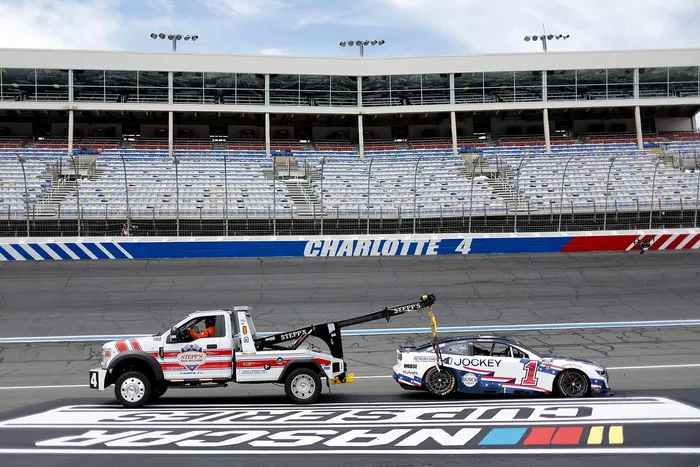Introduction: A Triumph Against All Odds
On May 25, 2025, at Charlotte Motor Speedway, Ross Chastain delivered one of the most remarkable performances in recent NASCAR history. Starting from the back of the field in a backup car, Chastain drove his No. 1 Chevrolet to victory in the Coca-Cola 600, NASCAR’s longest race and one of its crown jewel events. The win marked Trackhouse Racing’s first triumph in this prestigious race, but the story behind the victory was even more extraordinary. A tire failure during practice wrecked Chastain’s primary car, forcing the Trackhouse Racing team into a frantic, all-night effort to prepare a backup car. Described as a “Herculean effort” by the team, this remarkable feat of teamwork, ingenuity, and determination turned disaster into triumph. This article delves into the challenges, the preparation, and the sheer grit that defined Trackhouse Racing’s unforgettable weekend.
The Setback: A Practice Crash Changes Everything
The Coca-Cola 600 weekend began with high expectations for Trackhouse Racing. Ross Chastain, known for his aggressive driving style and knack for outperforming expectations, was poised to compete for a strong finish. The team had meticulously prepared the No. 1 Chevrolet, fine-tuned for the grueling 600-mile race. However, during a practice session on Saturday, disaster struck. A tire failure sent Chastain’s car spinning into the wall, causing significant damage to the primary car. The crash was a gut punch to the team, as it meant they would need to switch to a backup car—a process that is never simple in the high-stakes world of NASCAR.
In NASCAR, a backup car is a secondary vehicle kept on standby for emergencies like crashes. While these cars are built to the same specifications as the primary car, they are often not as finely tuned or optimized. Preparing a backup car mid-weekend, especially for a race as demanding as the Coca-Cola 600, requires an extraordinary effort. The Trackhouse team had less than 24 hours to get the backup car race-ready, a task that would test their skills, stamina, and resolve.
The Herculean Effort Begins
As soon as the wrecked car was towed back to the garage, the Trackhouse Racing crew sprang into action. The team, led by crew chief Phil Surgen and team owner Justin Marks, faced a daunting challenge. The backup car, stored in the team’s hauler, needed to be prepped, configured, and tested in record time. Every component—from the suspension to the aerodynamics—had to be dialed in to match the performance of the primary car. The clock was ticking, and the team knew that any misstep could jeopardize their chances in the race.
The first step was to assess the backup car’s condition. While it was built to NASCAR’s strict specifications, it hadn’t been driven in competition or subjected to the same level of scrutiny as the primary car. The crew began by stripping the car down to its core components, checking every part for alignment, wear, and compatibility. This process alone took hours, as the team worked under the pressure of knowing that the race was less than a day away.
Technical Challenges: Building a Winner from Scratch
Preparing a backup car is not just a matter of swapping one vehicle for another. NASCAR teams spend weeks, sometimes months, fine-tuning their primary cars for specific tracks. The Coca-Cola 600, with its 400 laps and four distinct stages, demands a car that can balance speed, fuel efficiency, and tire wear over four hours of racing. The backup car, while structurally identical, lacked the precise setup that the team had developed for Charlotte Motor Speedway.
One of the biggest challenges was the suspension setup. The primary car had been optimized for Charlotte’s 1.5-mile oval, with its unique banking and surface characteristics. The backup car’s suspension needed to be adjusted to match, a process that required recalibrating shocks, springs, and sway bars. The team also had to ensure that the car’s aerodynamics were optimized for drafting and passing, critical for Chastain’s aggressive driving style. Every adjustment had to be perfect, as even a small misalignment could cost valuable time on the track.
Another hurdle was the electronics and telemetry systems. Modern NASCAR cars are equipped with sophisticated sensors and data systems that provide real-time feedback to the crew. These systems needed to be installed, tested, and calibrated on the backup car, a time-consuming process that required precision and expertise. The team worked through the night, with mechanics, engineers, and specialists collaborating to ensure every system was functioning flawlessly.
The Human Element: A Team United
Beyond the technical challenges, the preparation of the backup car was a testament to the Trackhouse Racing team’s unity and determination. The crew worked with almost no sleep, fueled by adrenaline and a shared commitment to giving Chastain a fighting chance. Posts on X captured the sentiment, with one user noting that the team had less than three hours of rest before the race.
Team owner Justin Marks played a pivotal role in keeping morale high. Known for his hands-on leadership, Marks was in the garage alongside the crew, offering encouragement and making critical decisions. Crew chief Phil Surgen, meanwhile, coordinated the effort with a calm but focused demeanor, ensuring that every task was prioritized and executed efficiently. The team’s tire specialists, suspension experts, and aerodynamicists worked in tandem, each contributing their expertise to the collective goal.
Ross Chastain, too, was deeply involved in the process. While he couldn’t turn wrenches himself, he stayed with the team late into the night, providing feedback on the car’s setup and boosting morale. Chastain’s trust in his team was evident, and his presence in the garage underscored the bond between driver and crew. As one X user put it, “Chastain punched above his weight class all year,” and this weekend was no exception.
The Race: From Last to First
When race day arrived, the Trackhouse team was exhausted but confident. The backup car, now fully prepped, was ready to take on the grueling 600 miles of the Coca-Cola 600. Because of the crash in practice, Chastain was forced to start at the back of the 40-car field—a daunting position in a race known for its intensity and attrition. Yet, Chastain and the team were undeterred.
From the green flag, Chastain began his charge through the field. The backup car, despite its rushed preparation, performed remarkably well. The team’s adjustments to the suspension and aerodynamics paid off, allowing Chastain to carve through traffic with precision. His aggressive driving style, often described as fearless, was on full display as he passed car after car, steadily climbing the leaderboard.
The Coca-Cola 600 is a test of endurance, not just for the driver but for the car itself. Tire wear, fuel strategy, and pit stops play a critical role in determining the outcome. The Trackhouse crew executed flawless pit stops, with each member performing their role with precision. The team’s strategy, guided by Surgen, balanced speed with conservation, ensuring that Chastain had the car he needed for the final stages of the race.
As the laps wound down, Chastain found himself in contention for the lead. The final stage of the race saw him battling some of NASCAR’s biggest names, including former champions and playoff contenders. With a combination of bold moves and strategic patience, Chastain took the lead in the closing laps and held off all challengers to claim the victory. The crowd erupted as he crossed the finish line, and the Trackhouse garage celebrated a win that felt like a miracle.
The Aftermath: A Milestone for Trackhouse
The victory was more than just a win for Ross Chastain—it was a defining moment for Trackhouse Racing. Founded in 2020, Trackhouse is a relatively new team in NASCAR, competing against established powerhouses like Hendrick Motorsports and Joe Gibbs Racing. The Coca-Cola 600 win was a statement that Trackhouse could compete at the highest level, even under the most challenging circumstances.
Social media buzzed with praise for the team’s effort. One X post called it “Trackhouse’s first crown jewel,” highlighting the significance of the win. Another user described Chastain’s drive as “helluva,” noting that it was an incredible finish in a season that had been challenging for the team. The motorsport community recognized the victory as a testament to Trackhouse’s potential, with many predicting that this was just the beginning of their rise.
Lessons Learned: The Power of Teamwork
The story of Trackhouse Racing’s Coca-Cola 600 victory is one of resilience, collaboration, and belief in the face of adversity. The team’s ability to rally after a devastating setback showed the strength of their culture and the depth of their talent. From the mechanics who worked tirelessly in the garage to the strategists who crafted a winning game plan, every member of the team played a role in the victory.
For Ross Chastain, the win was a validation of his talent and determination. Known for his blue-collar work ethic and fearless driving, Chastain proved that he could compete with the best in the sport. His ability to trust his team, even when starting from the back, was a key factor in the victory.
The broader NASCAR community also took note. The sport thrives on stories of underdogs overcoming the odds, and Trackhouse’s win was a perfect example. It reminded fans and competitors alike that in racing, preparation and teamwork can make the impossible possible.
Conclusion: A Legacy in the Making
Trackhouse Racing’s “Herculean effort” at the Coca-Cola 600 will go down as one of the great stories in NASCAR history. The team’s ability to transform a practice crash into a race-winning performance is a testament to their skill, determination, and unity. For Ross Chastain, the victory was a career-defining moment, solidifying his place among NASCAR’s elite. For Trackhouse, it was a milestone that signaled their arrival as a force to be reckoned with.
As the 2025 NASCAR season continues, Trackhouse Racing will carry the momentum of this win forward. The team’s story is a reminder that in motorsport, as in life, challenges can be overcome with hard work and belief. The Coca-Cola 600 was more than just a race—it was a triumph of the human spirit, a victory that will be remembered for years to come.


